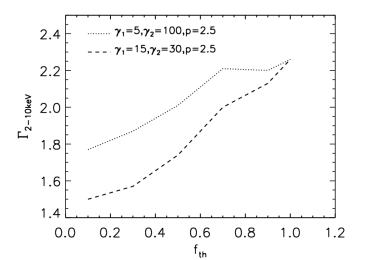The Monthly Notices of the Royal Astronomical Society, recently published the research results of Dr. LIU Jieying and Researcher MAO Jirong from the Yunnan Observatories of the Chinese Academy of Sciences, along with Researcher LIU Bifang from the National Astronomical Observatories. Their work proposes that the relatively flat X-ray spectrum with hard X-ray photon index Γ2-10keV < 2.1 in luminous active galactic nuclei (AGN), is generated from a magnetic-coupled disc-corona accretion flow. This flow is unique in that it comprises both thermal and non-thermal electrons.
In the center of luminous AGNs, lies a supermassive black hole. This black hole is the powerhouse behind the galaxy’s emission of multi-wavelength. It plays a crucial role in the growth of the black hole itself and the evolution of the galaxy.
The energy that fuels this emission comes from a process called accretion, where matter spirals into the black hole. This accretion flow is made up of a disk and a corona. The disk emits low-energy light, like optical and UV photons, which gets boosted to X-ray levels when it interacts with hot electrons in the corona.
The relationship between the disk and the corona, how the corona forms, and its energy source are hot topics in astronomy. The co-author, Researcher LIU Bifang have developed a model based on how the Sun’s corona is heated. They suggest that some of the energy from the disk accretion is stored in loops of magnetic flux. These loops rise into the corona due to buoyancy and reconnect with loops moving in the opposite direction. This process releases the magnetic energy as heat, keeping the corona hot and producing strong X-ray radiation.
However, the magnetic-reconnection-heated corona, which contains only thermal electrons, can generate X-ray spectrum with Γ2-10keV> 2.1. In the new work, Dr. LIU et al. develop the magnetic-reconnection-heated corona model that considers the potential non-thermal electrons accelerated during the magnetic reconnection process, in addition to the thermal electrons.
The corona achieves equilibrium through the inverse Compton scattering of both thermal and non-thermal electrons. The researchers find that the X-ray spectrum is significantly affected by both the energy fraction and the distribution of non-thermal electrons (Figure 1).

Figure 1, The photon index Γ2-10keV as a function of energy fraction fth. Two different distributions of non-thermal electrons are compared. For the same distribution of non-thermal electrons, as the value of fth decreases, indicating an increase in the energy fraction of non-thermal electrons, the X-ray photon index decreases. Image by LIU.
Furthermore, they compared the radiation spectrum of the theoretical model with the observational data from Swift satellite. Their findings suggest that a large fraction (> 40%) of the magnetic energy be allocated to the non-thermal electrons in the luminous AGNs of flat X-ray spectrum (Figure 2).

Figure 2, Comparison of the theoretical model with partial observational data. The black lines represent the total radiation spectra of the disk-corona containing thermal and non-thermal electrons; The dotted lines represent the radiation spectra of the accretion disk and the thermal electrons in the corona. The dashed lines represent the radiation spectra of the non-thermal electrons in the corona. The gray lines represent the total radiation spectra of the disk-corona with only thermal electrons included. The red dots represent the observational data from the Swift satellite. Image by LIU.
Future studies of the X-ray polarization feature of the corona, combined with observational results from X-ray polarization telescopes such as the Imaging X-ray Polarimetry Explorer (IXPE), POLAR-2, and the Enhanced X-ray Timing and Polarimetry mission (eXTP), will effectively constrain the properties of the magnetic field, which is a key factor in the magnetic-reconnection-heated corona model. The distribution of electrons in the X-ray corona can also be further determined.
This work has been supported by the National Key R&D Program of China, the National Science Foundation of China, CSST grant, the Yunnan Revitalization Talent Support Program YunLing Scholar Project and Young Talent Project (Notice: The publicity has been completed), the Natural Science Foundation of Yunnan Province, and the International Centre of Supernovae, Yunnan Key Laboratory.
Contact:
LIU Jieying
Yunnan Observatories, CAS
E-mail:ljy0807@ynao.ac.cn